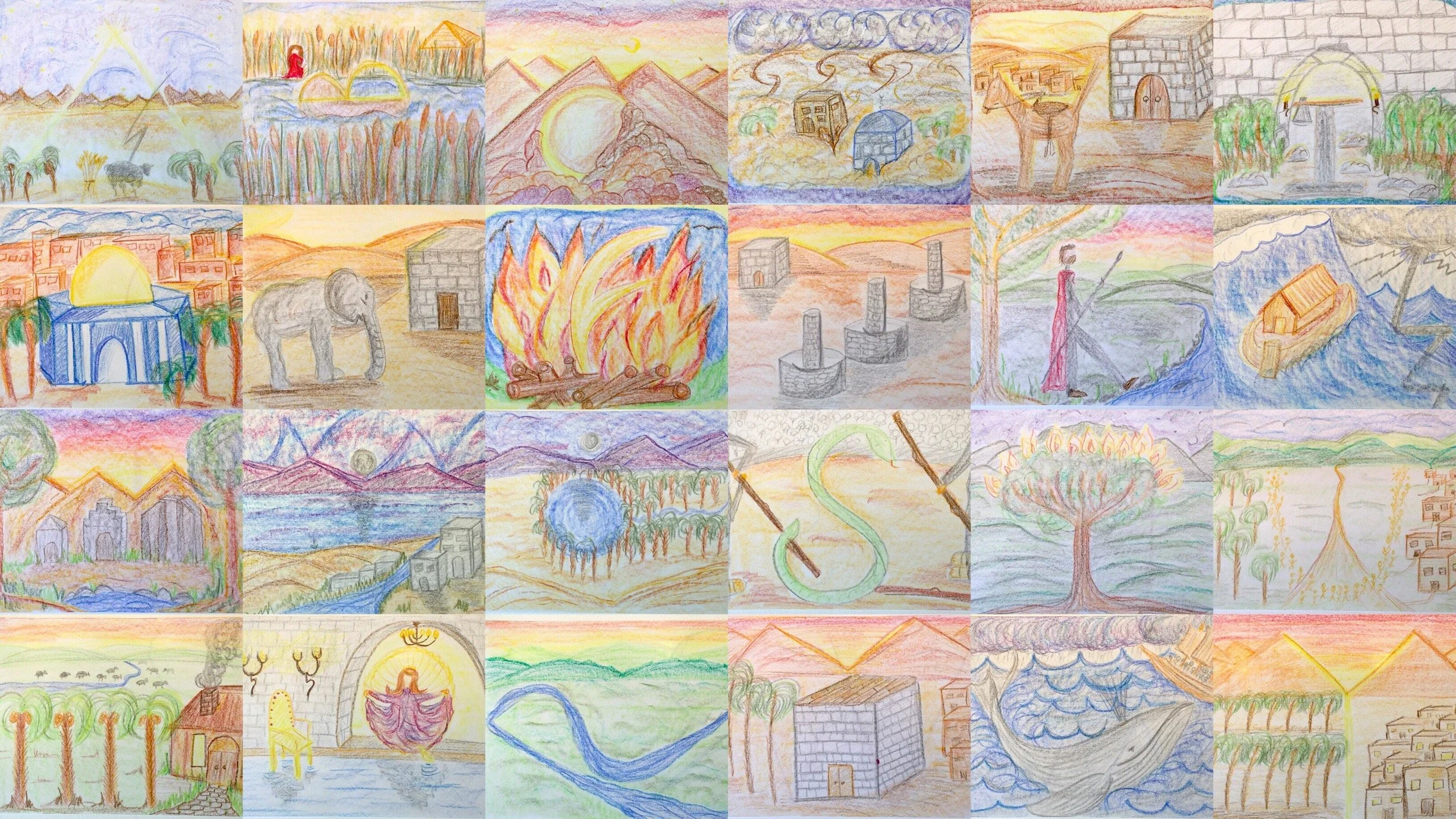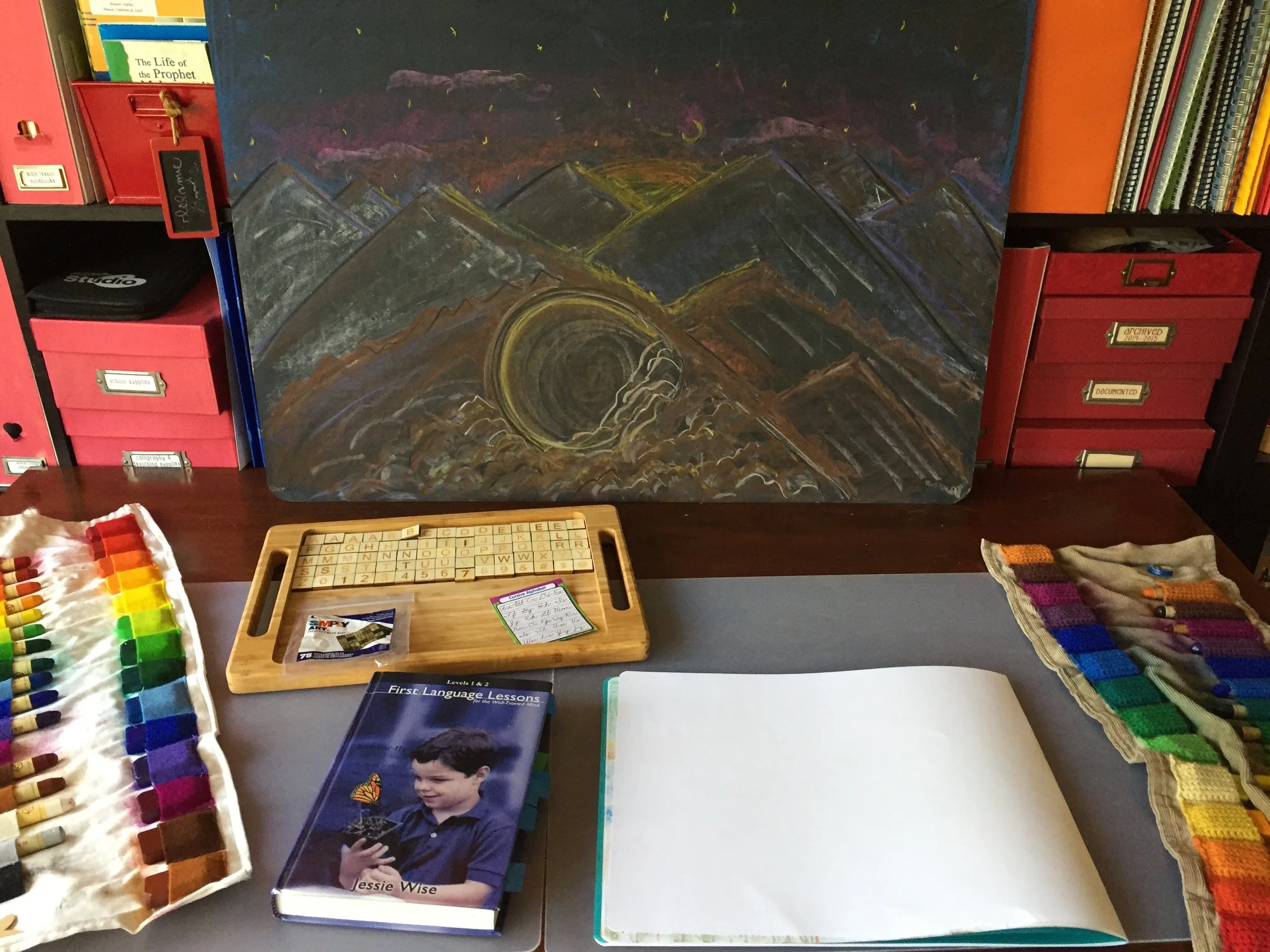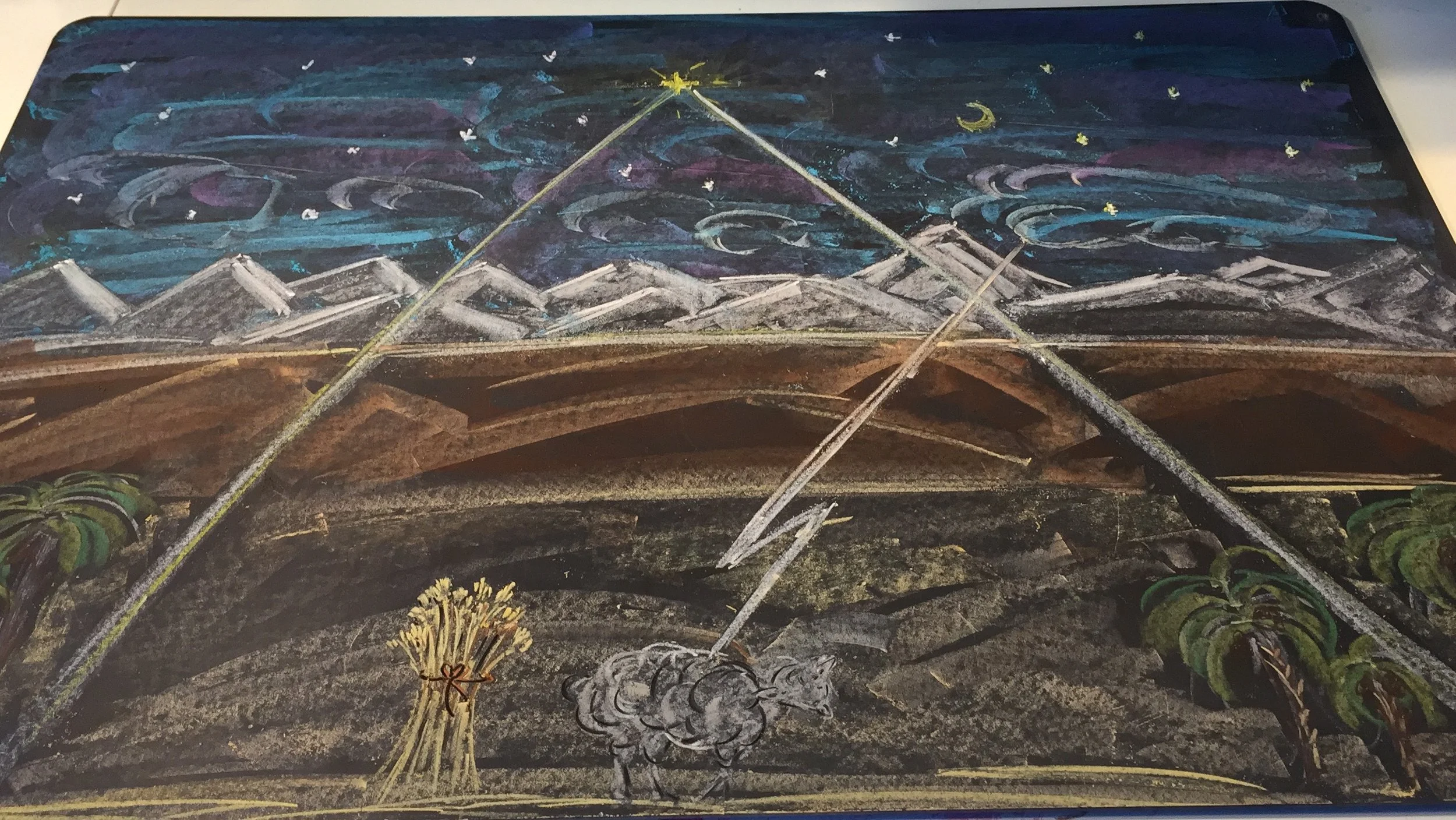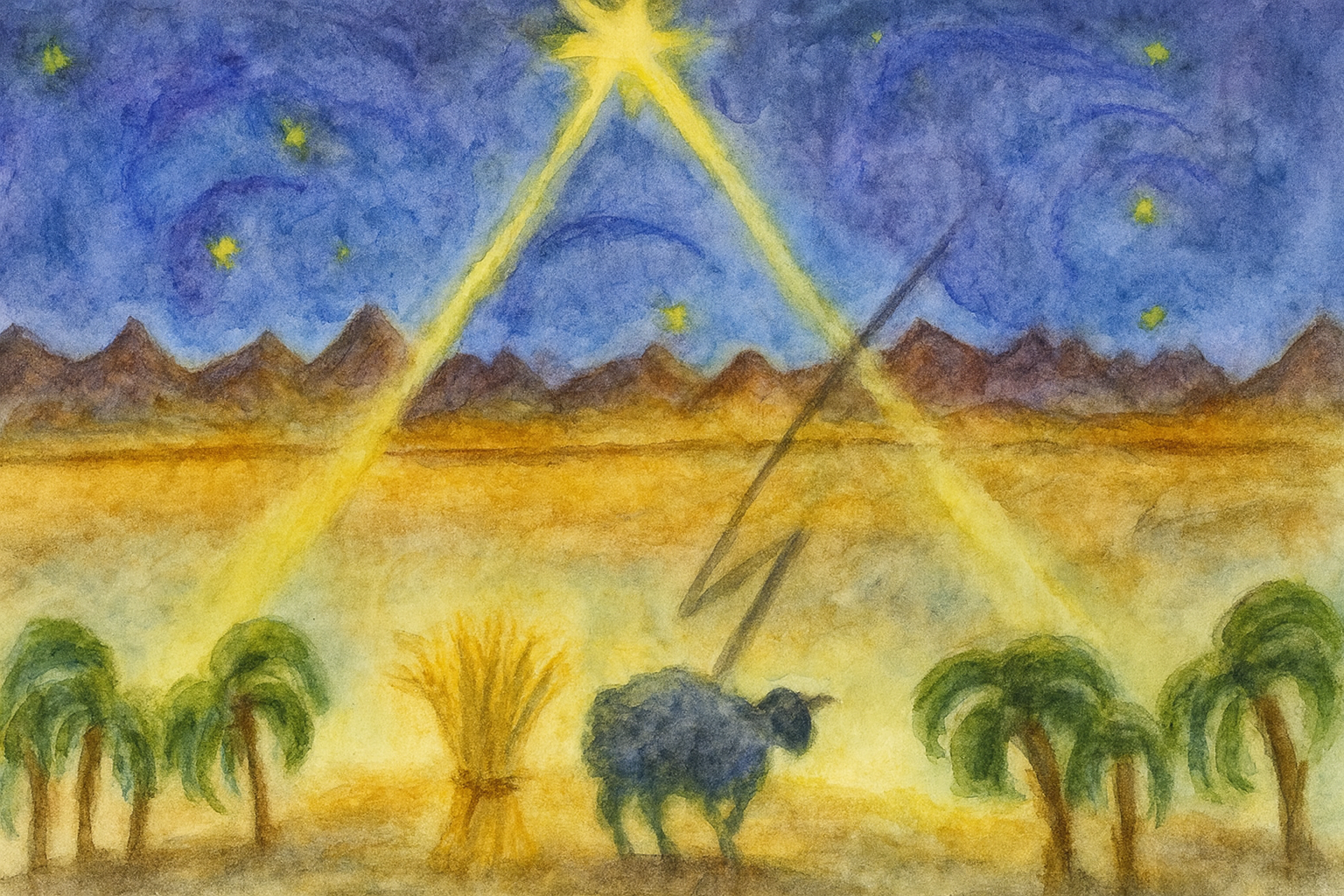
Letters of the Alphabet
Through the Prophetic Stories of the Stories of the Previous Prophets (as)
The following main lesson block was inspired by the Letters Main Lesson Block in a Waldorf curriculum for grade one. Formal education in Waldorf education begins at the age of seven after the loss of the baby teeth. This is inline with the Islamic teachings of beginning formal education at the ‘age of awareness’ which is at about age seven as well. When exploring the development of the human being, one will find many similarities in the various educational philosophies, primarily because human nature is observable and these developmental changes are part of Allah’s (swt) creation. What differs in each philosophy is the methodology. In this case, the method of teaching the alphabet is to present each letter with a story in which the letter itself is part of the drawing in the shape of the word it represents.
Why Prophet Stories versus Fairy Tales ?
Traditionally in a Waldorf curriculum, the letters of the alphabet are introduced with stories based on Grimm’s Fairy Tales. These stories were chosen for the archetypal characters which reflected human nature in the profound sometimes extreme way. Good and Evil, and Heroism and Cowardice are some of the archetypal characters you’ll find in stories like Little Red Riding Hood or the Three Bears. Rather than choosing stories from Grimm’s Fairy Tales, this curriculum will utilize the rich and diverse stories of the previous prophets are the story content for these lessons. Themes of good versus evil, right versus wrong and truth versus falsehood are echoed again and again throughout this curriculum. While some stories carry heavy themes of sorrow, defeat or despair, they are juxtaposed with stories of happiness, triumph and hope. All stories attempt to end on a note of resolution and triumph.
Resources
The following resources have been used to sources the content for these stories.
Stories of the Prophets by Imam Ibn Kathir Translated by Sheikh Muhammad Mustafa Gemeiah Edited by AElfwine Acelas Mischler El-Nour Publishing Distribution and Translation, The Sealed Nectar by Safi-ur-Rahman al-Mubarakpuri, and Prophets of Allah volume I-IV by Suhaib Hamid Ghazi and published by Iqra International Educational Foundation. For the Letter N story, Al-Khidr and the Green One by Hugh Talat Halman with illustrations by 'Abdullah Lipton. This book is available from IQRA International Educational Foundation. Original poems have been composed for each letter and are presented alongside with the lesson.
Videos for each lessons can be found on YouTube at Pepper and Pine. Each Letter contains three separate videos: A chalk drawing, a lesson and the story.
I’ve used small chalkboards to draw each lesson using Sargent Art Chalk Pastels.
Block and Stick crayons are typically used by children in Waldorf schools, and while I think they are a worthy investment, any crayon will do. We use large main lesson books measuring 14”x11”. If you can’t source them in your area, you can use large sheets of drawing paper and bind them when the lessons are completed.
The Setup
Here’s our set up in our homeschool room with the chalk drawing resting on our desk and all our supplies and opening activities ready to go. We worked through 25 lessons in First Language lessons during this unit.
While added grammar in the form of First Language Lessons 1 and 2 from Peace Hill Press is not in keeping with Waldorf tradition, I did add those oral lessons as part of our opening activities starting the second week of this main lesson block.
How to teach this series
If you are new to the Waldorf philosophy, the 2-3 day learning/teaching method may seem unusual and initially difficult to implement. Even with my Waldorf experience, I didn’t find my rhythm for this unit until a week or two into the unit. What finally worked well for us was to tell my daughter the story for the lesson as a bedtime story the night before we did the lesson.
I would draw the chalk drawing for the lesson the day before or the day of the lesson, sometimes just before the lesson. My children would be doing something else when I drew the chalk drawing. I would then present the chalkboard to the children (my 12-year-old enjoyed seeing them). Then we would begin the lesson which would include opening activities like games and grammar, a recap of the story, the crayon drawing and printing and practicing the letter of the day.
You may also choose to save the printing practice for the third day. So here’s what a lesson might look like a few days into the unit: Let’s say it’s day two and you are beginning the lesson on the Letter B (you’ve told the story the night before). You might be drawing the Letter B crayon drawing with your child while review the Letter B story. When the lesson is complete, recap the lesson from the previous day, the Letter A. As you review that lesson, you can begin print and practicing the letter A uppercase and lowercase.
Later in the day or evening you can complete the lesson with the story for Letter C. In this way, you are covering three letters in one day in different stages of the lesson. If you think of the lesson being composed of three stages: The story, the crayon drawing and the printing practicing. You can do each one on a day, but still do a full lesson because you’ll be covering three letters a day.
I know this may take some time to understand and even longer to implement and still longer before you find your rhythm, but it’s thrilling when it comes together. If that doesn’t work for your situation, take care in knowing that even if you do a complete lesson in one day with just one letter, you will be just fine!
Letter A Chalk Drawing
This chalk drawing on the Letter A is the first in a series of videos dedicated to the Letters Main Lesson Block typically found in a Waldorf curriculum. This series depicts an Islamic version of the main lesson block featuring original art, lessons and stories (with the exception of two chalk drawings inspired by the Live Education! curriculum), based on religious and cultural texts relevant for the Muslim or religious family. Content for the stories is based on various stories found in the lives of the previous prophets. Each letter can be found in the drawing in the shape of a word that begins with that drawing (with some exceptions). Each lesson includes a story about that word/drawing as well as other grammar, phonics, and handwriting lessons. Content for each lesson has been sourced from various Islamic texts including Ibn Kathir’s Stories of the Prophets, Prophets of Allah volume I-IV by Suhaib Hamid Ghazi and published by Iqra International Educational Foundation and The Sealed Nectar by Safi-ur-Rahman al-Mubarakpuri. Original poems have been composed for each letter and are presented alongside with the lesson.
Lesson A includes a chalk drawing with a shining star illuminating the horizon creating the letter A. While star doesn’t begin with A, the story is about Allah, Adam (alahi salam) and all of Allah’s creations. So Allah and Adam (alahi Salam) cannot be depicted, the radiance of Allah’s creation is shown in the light shining from the star. The story also includes the events depicted in the Qur’an about Kabeel and Habeel.
This chalk drawing on the Letter A is the first in a series of videos dedicated to the Letters Main Lesson Block typically found in a Waldorf curriculum. This series depicts an Islamic version of the main lesson block featuring original art, lessons and stories (with the exception of two chalk drawings inspired by the Live Education! curriculum), based on religious and cultural texts relevant for the Muslim or religious family. Content for the stories is based on various stories found in the lives of the previous prophets. Each letter can be found in the drawing in the shape of a word that begins with that drawing (with some exceptions). Each lesson includes a story about that word/drawing as well as other grammar, phonics, and handwriting lessons. Content for each lesson has been sourced from various Islamic texts including Ibn Kathir's Stories of the Prophets, Prophets of Allah volume I-IV by Suhaib Hamid Ghazi and published by Iqra International Educational Foundation and The Sealed Nectar by Safi-ur-Rahman al-Mubarakpuri. Original poems have been composed for each letter and are presented alongside with the lesson.
Lesson A includes a chalk drawing with a shining star illuminating the horizon creating the letter A. While star doesn't begin with A, the story is about Allah, Adam (alahi salam) and all of Allah's creations. So Allah and Adam (alahi Salam) cannot be depicted, the radiance of Allah's creation is shown in the light shining from the star. The story also includes the events depicted in the Qur'an about Kabeel and Habeel.
Letter A Story| Prophet Adam (as) & Allah's Creation
The Story for the Letter A: Prophet Adam (as) and the story of creation is the first in a series of videos dedicated to the Letters Main Lesson Block typically found in a Waldorf curriculum. This series depicts an Islamic version of the main lesson block featuring original art, lessons and stories (with the exception of two chalk drawings inspired by the Live Education! curriculum), based on religious and cultural texts relevant for the Muslim or religious family. Content for the stories is based on various stories found in the lives of the previous prophets.
Each letter can be found in the drawing in the shape of a word that begins with that drawing (with some exceptions). Each lesson includes a story about that word/drawing as well as other grammar, phonics, and handwriting lessons. Content for each lesson has been sourced from various Islamic texts including Ibn Kathir's Stories of the Prophets, Prophets of Allah volume I-IV by Suhaib Hamid Ghazi and published by Iqra International Educational Foundation and The Sealed Nectar by Safi-ur-Rahman al-Mubarakpuri. Original poems have been composed for each letter and are presented alongside with the lesson.
Lesson A includes a chalk drawing with a shining star illuminating the horizon creating the letter A. While star doesn't begin with A, the story is about Allah, Adam (alahi salam) and all of Allah's creations. So Allah and Adam (alahi Salam) cannot be depicted, the radiance of Allah's creation is shown in the light shining from the star. The story also includes the events depicted in the Qur'an about Kabeel and Habeel.
Lesson Letter A | Islamic Stories Main Lesson Block
This lesson drawing on the Letter A is the first in a series of videos dedicated to the Letters Main Lesson Block typically found in a Waldorf curriculum. This series depicts an Islamic version of the main lesson block featuring original art, lessons and stories (with the exception of two chalk drawings inspired by the Live Education! curriculum), based on religious and cultural texts relevant for the Muslim or religious family. Content for the stories is based on various stories found in the lives of the previous prophets.
Each letter can be found in the drawing in the shape of a word that begins with that drawing (with some exceptions). Each lesson includes a story about that word/drawing as well as other grammar, phonics, and handwriting lessons. Content for each lesson has been sourced from various Islamic texts including Ibn Kathir's Stories of the Prophets, Prophets of Allah volume I-IV by Suhaib Hamid Ghazi and published by Iqra International Educational Foundation and The Sealed Nectar by Safi-ur-Rahman al-Mubarakpuri. Original poems have been composed for each letter and are presented alongside with the lesson.
Lesson A includes a crayon drawing with a shining star illuminating the horizon creating the letter A. While star doesn't begin with A, the story is about Allah, Adam (alahi salam) and all of Allah's creations. So Allah and Adam (alahi Salam) cannot be depicted, the radiance of Allah's creation is shown in the light shining from the star. The story also includes the events depicted in the Qur'an about Kabeel and Habeel.







